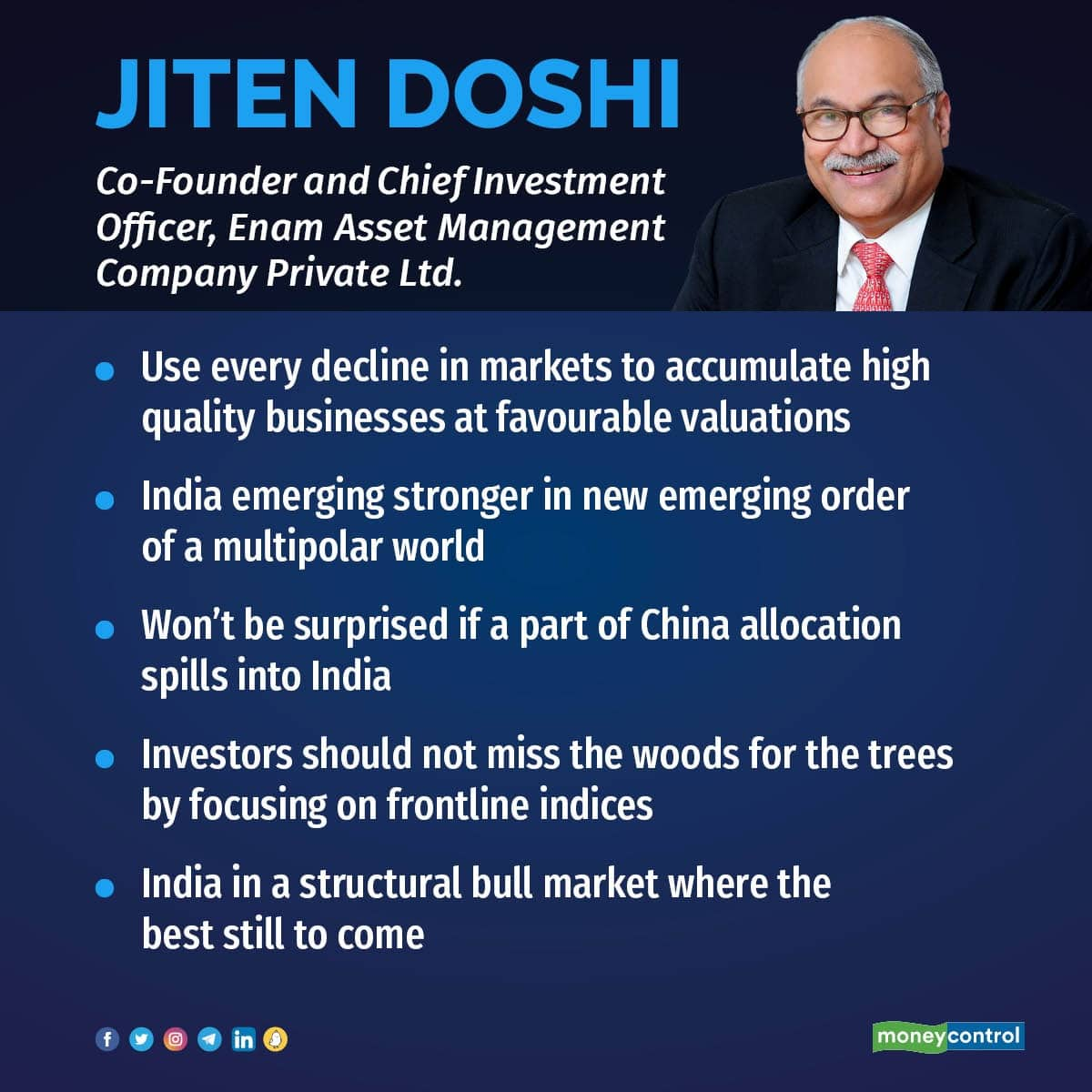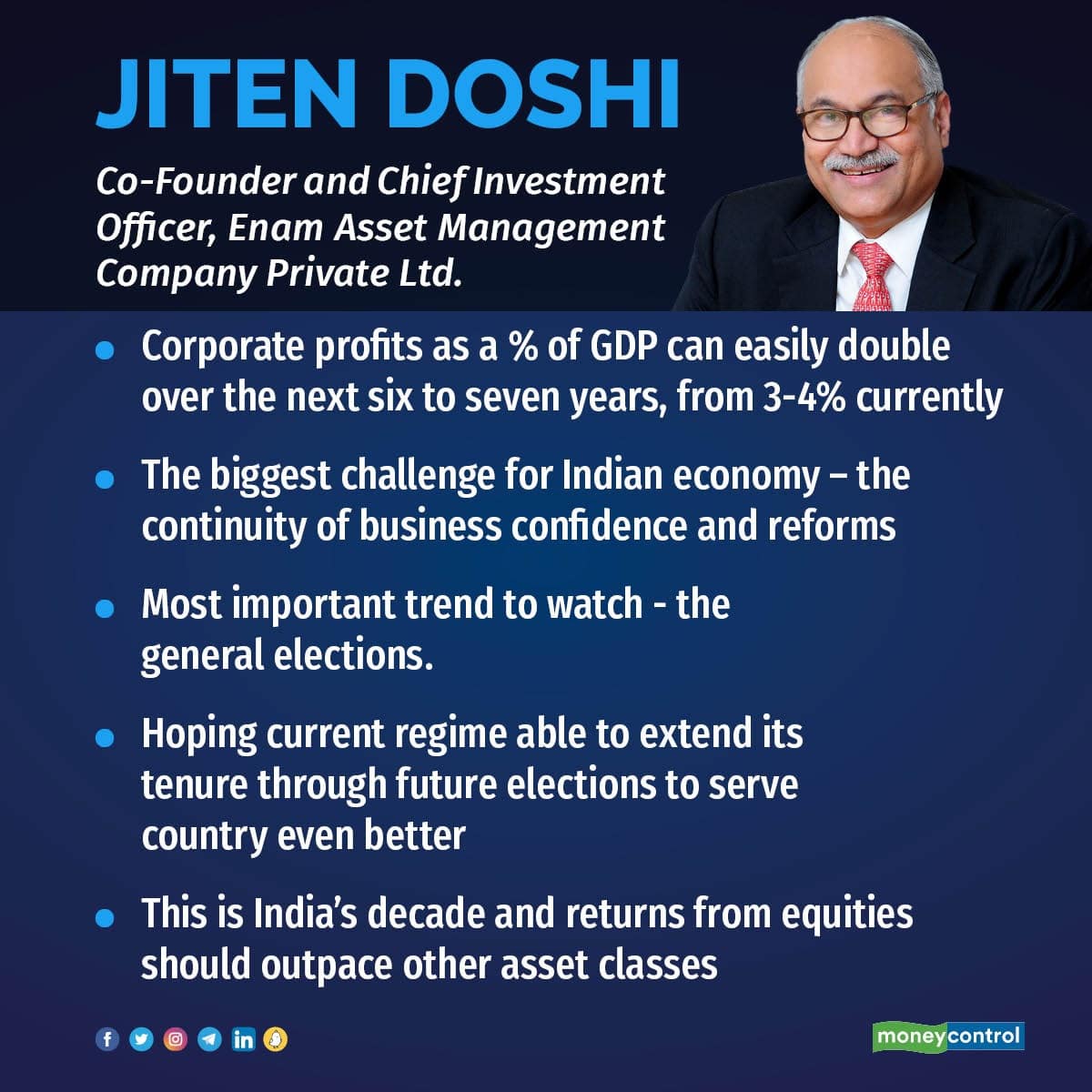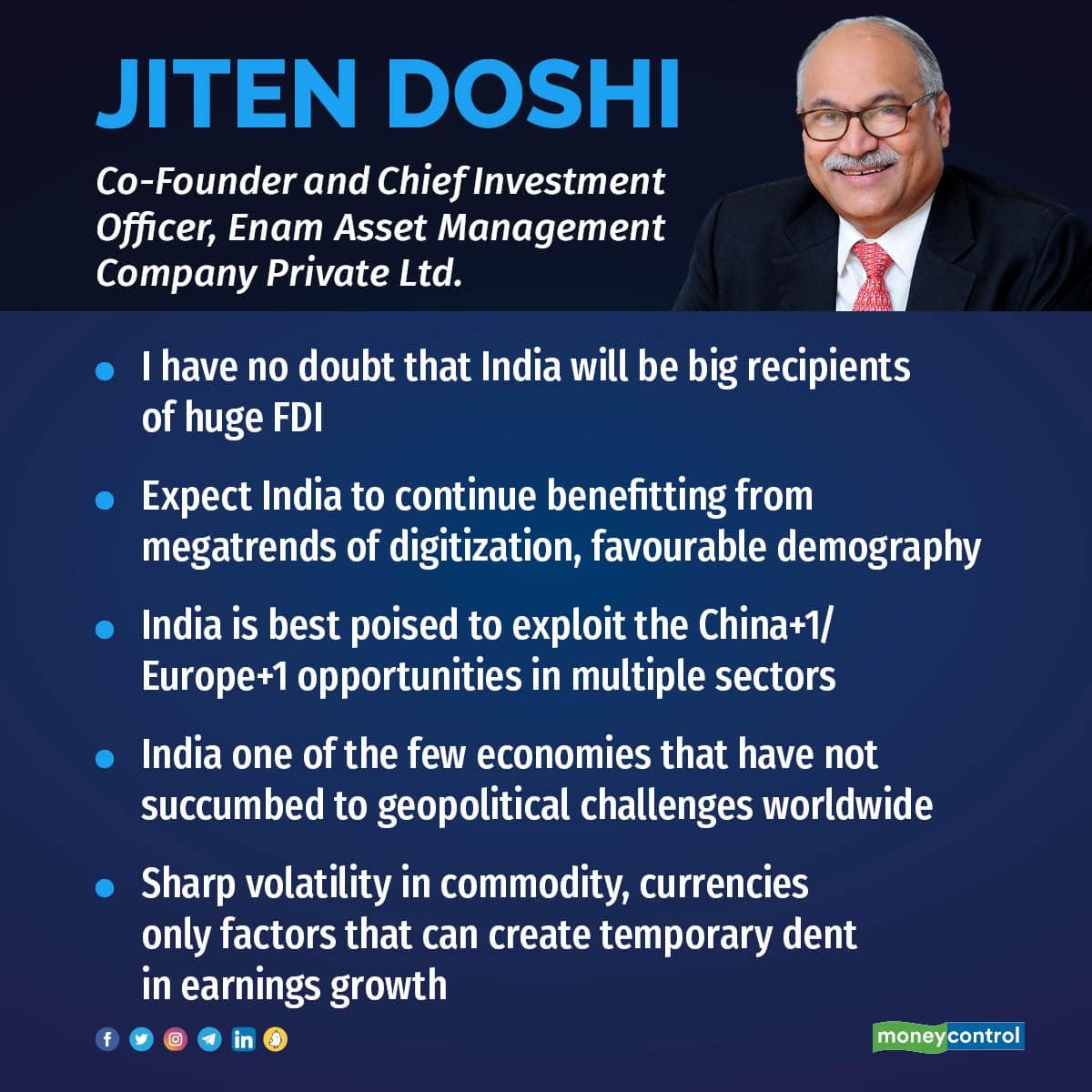
Jiten Doshi is the Co-Founder and Chief Investment Officer at Enam Asset Management Company
This is India’s decade and returns from equities should outpace other asset classes, Jiten Doshi, Co-Founder and Chief Investment Officer of Enam Asset Management Company, says in an interview to Moneycontrol.
With an experience of over 30 years in capital markets, Doshi expects India to continue benefitting from megatrends of digitisation, favourable demography, development, formalisation, consolidation, urbanisation, improving rural incomes and affordable aspirations, which create a vibrant domestic economy.
He believes India is in a structural bull market where the best is still to come and there are multiple opportunities to create long-term wealth.
Hence, stay invested in high-quality businesses to generate outsized returns over the long term, and any correction in the markets should be used to add high-quality names to the portfolio, he says. Investors should not miss the woods for the trees by focusing on frontline indices, Doshi advises.
However, the only factor that can temporarily dent earnings growth is sharp volatility in commodities and currencies causing producers to bear the brunt in the short term, says Doshi but believes that the long-term earnings growth trajectory is very strong and going forward investors will be positively surprised with corporate profitability.
What are the emerging themes/opportunities for investors?
India has been through a major transformation for more than 8 years now. The current government has laid the foundation for strong, stable and well-balanced growth. Reforms across sectors like agriculture, defence, and administration are next on the agenda. The first five years of the Modi regime were spent on cleaning up the mismanagement of the past few years. In the current term from 2019, the government has demonstrated the building and strengthening of India’s economic foundation. During a worldwide geopolitical crisis, the Indian economy has demonstrated great resilience. While there existed times of distress like demonetization, debt crisis, and pandemic, what gets hidden in oversight is the once-in-a-lifetime initiatives of creating building blocks for a $ 10 trillion prospect ready to take off with some structural strengths.

The high-intensity reform initiatives like Aadhar, bottom-of-the-pyramid implementations like Jan Dhan and Direct Benefit Transfer (DBT), cleaning of corporate loan book with IBC (Insolvency and Bankruptcy Code), successful large-scale yet deep implementation of GST, digitisation supported by a large-scale bandwidth explosion of cheap data as a bedrock, publicly owned digital infra initiatives like UPI/IMPS/India Stack/Cowin, and a renewed focus on health/education has readied India for the next leg of growth.
Given that India is now the only large economy with so much growth and investment potential, I have no doubt that we shall be big recipients of huge FDI.
Given the above scenario, I am very bullish and see opportunities across several sectors. The growth that we will witness over the next few years will be broad-based and sustainable. We expect India to continue benefitting from megatrends of digitisation, favourable demography, development, formalisation, consolidation, urbanisation, improving rural incomes and affordable aspirations – which create a vibrant domestic economy. This also provides a strong local market anchor for exports where India is best poised to exploit the China+1/ Europe+1 opportunities in multiple sectors like Light Engineering, Specialty Chemicals, Textiles, Automation, etc. Investors should carefully choose the investible sectors and stocks within that and stay invested in the India story.
Do you expect better profitability growth for India Inc in the coming years given the significant reforms we have seen in the last several years?
When I look back at the past eight years since Modi became Prime Minister, I believe the government has been doing all the right things to create an environment of trust and sustainability. While the first 5 years of reforms from 2014 to 2019 were indeed painful, they were structural in nature. Few people realised they were very crucial to strengthen our foundation. What the current government has done is amply visible in the economic and investment environment today.

India is one of the few economies that have not succumbed to geopolitical challenges worldwide. In fact, we become even stronger and now relevant to the global economy. Those countries that had written off India are now interested in investing in India. Prior to 2014, crony capitalism was fuelling economic growth but was not sustainable.
The growth today is supported by several fundamental vectors and can sustain because of continuous momentum. If I were to draw a parallel to the period between 2005 to 2008 with what is happening now then I can see a big difference. In the period between 2005 and 2008, India’s boom was fuelled by external capital and huge investments went into commodities, real estate, and infrastructure and India then created a lot of crony capitalists with no experience in execution. Today the growth is very broad-based with a consumption boom, a housing boom, increasing exports due to China plus one story, a focused effort on energy transition, the start of a capex cycle and the government’s push towards the creation of infrastructure. This makes the earnings growth momentum visibly sustainable.
The only factor that can create a temporary dent in the earnings growth is the sharp volatility in commodities and currencies causing producers to bear the brunt of these sharp swings in the short term. I believe the long-term earnings growth trajectory is very strong and going forward investors will be positively surprised by corporate profitability. While corporate profits as a percentage of GDP currently stand at 3-4 percent, they can easily double over the next six to seven years.
What are the biggest challenges for the Indian economy and equities?
The biggest challenge for the Indian economy is the continuity of business confidence and reforms. Last few years, India witnessed major structural reforms launched under the leadership of PM Modi to improve the overall outlook of the economy. Various economic reforms started by the government such as improvement in ease of doing business, opening up FDIs, the push for infrastructure development and a stable and decisive policy environment have catalysed India’s transformation.
India needs a government like the current one for at least another two terms beginning in 2024. The challenges for the equity markets are our own mindset. As Indians, we haven’t seen much progress for 67 years till recently. Indian investors are in disbelief at what they are witnessing and what is about to unfold. While India has undergone a major transformation it is unbelievable to see it stand so resilient during geopolitical turmoil and global slowdown. This hasn’t happened because of what we did last year or the year before that, but this is the result of a carefully executed plan by the Modi government since 2014.
India underwent a few structural changes ensuring the creation of processes and institutions. The introduction of GST, RERA, lowering of corporate tax rates, Jan Dhan, rapid digitisation of the economy, faceless assessment of tax returns, much greater transparency in the functioning of the government, etc are fundamental changes that have inspired confidence in the Indian entrepreneur. We need to believe in the India story. There is tremendous opportunity in the equity markets.
India offers among the most diversified palette of opportunities when it comes to diversity dispersion in terms of sectors, market participation (DII/FII/retail) and market capitalisation. Unlike many of its EM (emerging markets) counterparts – India is benefiting from the emergence of its local institutions driven by a strong vector of systematic flows of savings towards financial assets in general and equities in specific. This has absorbed most of the selling pressures of the FIIs. India has a vibrant equity culture. Our returns during the next phase will be determined by our belief in the India growth story and our ability to stay invested in great businesses at the right valuations.
What are the key trends to watch out for in HNIs’ investment strategies in the coming year?
The key trends to watch out for HNI investors would be many. The top trend is the rate of growth and its sustainability for the Indian economy. The megatrends mentioned earlier like rising domestic consumption, growth in exports, a housing boom, gradual FDI inflows, creation of infrastructure, etc. are strong, sustainable, and deep-rooted to the evolving India story. Investors need to watch carefully if there is any reversal in these drivers of economic growth. On the other hand, there has been a structural decline in interest rates so any upward rise in rates should not be worrying investors too much. The most important trend to watch is the general elections where we are hoping the current regime is able to extend its tenure through future elections to serve the country even better.

We feel this is India’s decade and returns from equities should outpace other asset classes. Obviously, there is a lot of geopolitical turmoil and rate hikes by global central banks. One needs to be watchful of the same and use every decline in markets to accumulate high-quality businesses at favourable valuations.
Do you expect significant FII inflow in the coming quarters? Would there be any major impact on flow if China reopens the economy?
We should stop focusing on short-term flows as that is only a gauge of volatility. What is more important is the structural changes that are being witnessed globally. India is now featuring in the minds and portfolios of all large global institutional investors. The shift post the Covid-19 crisis and the Ukraine-Russia war has been structural.
India is emerging stronger in the new emerging order of a multi-polar world. There were many large China investors who had ignored India for very long. These investors are beginning to realise the power and long-term potential of India.
It is my belief that as India opens up for FDI, we will see huge FPI inflows too. The confidence that global FPIs get with huge FDI coming to India is immense.
To my mind, India was not receiving its rightful share of inflows and that will change with huge inflows expected in the coming months, quarters and years. I wouldn’t be surprised if a part of the China allocation spills into India and we receive a few hundred billion dollars of FPI inflows over the next couple of years.
It is not about China re-opening but a matter of confidence and de-risking. Global investors were already overweight on China – and have faced the brunt of an underperforming market in an economy that claimed world-beating growth for decades.
The last 2 years of geopolitical events and China’s role in handling the same is something that has discomforted global investors. There is a sense of caution while committing further capital to China. Investors are wanting to diversify and de-risk hence we should look at the future more from a strategic perspective.
Given the pricing in most of the negative news, do you think the Nifty 50 will hit 20,000 in the coming months and that a major correction is unlikely in the medium term?
Professor Benjamin Graham said “In the short run, the market is like a voting machine — tallying up which firms are popular and unpopular. But in the long run, the market is like a weighing machine — assessing the substance of a company”. We are bad at predicting index levels as we are bottom-up stock pickers with a focus on the themes, industries and companies in our portfolio.
Also, time and again, investors have lost out while trying to time their entry into the markets. Our mantra continues to remain the same – Identify high-quality businesses within built moats and take a long-term view of their growth prospects while trying to buy into them with a reasonable margin of safety.
Any correction in the markets should be used to add high-quality names to the portfolio. Investors should not miss the woods for the trees by focusing on frontline indices. India is in a structural bull market where the best is still to come and there are multiple opportunities to create long-term wealth. Stay invested in high-quality businesses to generate outsized returns over the long term.
Disclaimer: The views and investment tips expressed by investment experts on Moneycontrol.com are their own and not those of the website or its management. Moneycontrol.com advises users to check with certified experts before taking any investment decisions.
